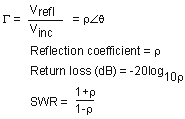

The ratio of the amplifier's output power (delivered to a Z0 load) to the input power (delivered from a Z0 source). Z0 is the characteristic impedance, in this case, 50W.
For small signal levels, the output power of the amplifier is proportional to the input power. Small signal gain is the gain in this linear region.
As the input power level increases and the amplifier approaches saturation, the output power reaches a limit and the gain drops. Large signal gain is the gain in this nonlinear region. See Gain Compression.
The variation of the gain over the frequency range of the amplifier. See Small Signal Gain and Flatness.
The measure of transmission from output to input. Similar to the gain measurement except the signal stimulus is applied to the output of the amplifier. See Reverse Isolation.
Gain Drift versus Time (temperature, bias)
The maximum variation of gain as a function of time, with all other parameters held constant. Gain drift is also observed with respect to other parameter changes such as temperature, humidity or bias voltage.
The amount of variation from a linear phase shift. Ideally, the phase shift through an amplifier is a linear function of frequency. See Deviation from Linear Phase.

The measure of the transit time through the amplifier as a function of frequency. A perfectly linear phase shift would have a constant rate of change with respect to frequency, yielding a constant group delay. See Group Delay.

The measure of the reflection mismatch at the input or output of the amplifier relative to the system Z0 characteristic impedance.

Complex impedance (1+G). The amount of reflected energy from an amplifier is directly related to its impedance. Complex impedance consists of both a resistive and a reactive component. It is derived from the characteristic impedance of the system and the reflection coefficient. See Complex Impedance.
See Gain Compression Application.
AM-to-PM Conversion Coefficient
![]()
The amount of phase change generated in the output signal of an amplifier as a result of an amplitude change of the input signal.
The AM-to-PM conversion coefficient is expressed in units of degrees/dB at a given power level (usually P1dB, which is the 1 dB gain compression point). See AM-PM Conversion.